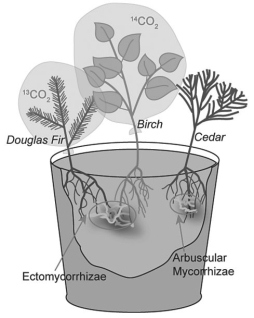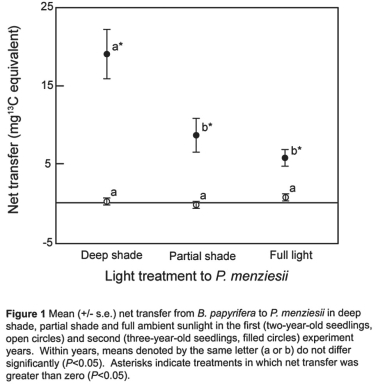Use the following information when answering the corresponding question(s) .
Suzanne Simard and colleagues knew that the same mycorrhizal fungal species could colonize multiple types of trees.They wondered if the same fungal individual would colonize different trees,forming an underground network that potentially could transport carbon and nutrients from one tree to another (S.Simard et al.1997.Net transfer of carbon between mycorrhizal tree species in the field.Nature 388:579-82) .Figure 31.2 illustrates the team's experimental setup.Pots containing seedlings of three different tree species were set up and grown under natural conditions for three years;two of the three species formed ectomycorrhizae (Douglas fir,birch) and the other (cedar) formed arbuscular mycorrhizae.For the experiment,the researchers placed airtight bags over the Douglas fir and birch seedlings;into each bag,they injected either carbon dioxide made from carbon-13 or carbon-14 (¹³CO₂ and ¹⁴CO₂,isotopes of carbon) .As the seedlings photosynthesized,the radioactive carbon dioxide was converted into radioactively labeled sugars that could be tracked and measured by the researchers.
Figure 31.2

Figure 31.3

-Simard et al(1997) further hypothesized that if reciprocal transfer did occur,it would be a source-sink relationship driven by photosynthetic rates.That is,if one seedling is in full Sun and the other in deep shade,there will be a net movement of carbon from the seedling in full Sun to the one in deep shade.If a shade was placed over the birch seedlings and the cedar,and the Douglas fir was left in full Sun,what result could Simard and colleagues expect?
Definitions:
Token Economy
A behavior modification system that uses tokens as a form of positive reinforcement for desired behaviors, which can later be exchanged for rewards.
Grooming Habits
Practices and activities related to personal care and cleanliness, including habits for maintaining appearance and hygiene.
Personalization
Distortion of thinking in which a person takes responsibility or blame for events that are unconnected to the person.
Overgeneralization
Distortion of thinking in which a person draws sweeping conclusions based on only one incident or event and applies those conclusions to events that are unrelated to the original; the tendency to interpret a single negative event as a never-ending pattern of defeat and failure.
Q2: Cloning of plants from cuttings demonstrates that
Q4: In an area with a high abundance
Q5: Which of these statements is not true
Q7: Aquaporins have been identified in the epithelium
Q7: Which of these is not a step
Q11: Through studies on the Malpighian tubules,researchers found
Q19: The mutation resulting in sickle cell anemia
Q23: Monocot vascular bundles do not have a
Q26: Which of the following explanations for brown
Q36: The researchers discovered a new proton pump